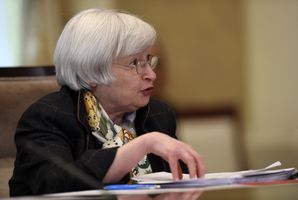WASHINGTON‑-The Federal Reserve held interest rates steady Wednesday for the second straight meeting and signaled it will raise rates more gradually than it previously forecast amid a weak global economy and market volatility, raising doubts about a June hike.
As widely expected, the Fed kept its key federal funds rate unchanged at 0.4%. It lifted the rate in December for the first time in nine years amid strong payroll gains and a near-normal unemployment rate of 5%.
But the Fed’s wary statement after a two-day meeting indicates policymakers are placing little stock in a recent market turnaround after a selloff early this year. It said “global economic and financial developments continue to pose risks.” It didn’t acknowledge a recent upswing that has seen stocks rally, corporate borrowing costs fall and the dollar weaken, developments that have prompted many economists to assert that the risk of recession has eased.
![Fed statement of March 16, 2016 [oembed : 81870286] [oembed : 81870286] [oembed : 81870286] [oembed : 81870286] [oembed : 81870286] [oembed : 81870286] [oembed : 81870286] [oembed : 81870286] [oembed : 81870286] [oembed : 81870286] [oembed : 81870286] [oembed : 81870286]](/Portals/_default/Skins/PrestoLegacy/CommonCss/images/smartembed.png)
Despite the recent upturn in markets,"economic growth abroad appears to be running at a somewhat softer pace than previously anticipated," Fed Chair Janet Yellen said at a news conference, citing a slowdown in China and sluggish growth in other emerging markets and the euro zone. Moving cautiously will let policymakers "verify that the labor market continues to strengthen despite the risks from abroad."
"The U.S. economy has been very resilient in recent months in the face of shocks," Yellen said.
The Fed also declined for a second straight meeting to assess the risks to its outlook, omitting that reference entirely. In January, it explicitly cited the global economic and market troubles. Many economists expected the Fed to state Wednesday that the risks were “nearly balanced,” a signal that it was on track to lift rates in June or possibly even April.
Fed policymakers’ forecasts indicated they expect just two quarter percentage point rate hikes in 2016, down from their estimate of four such increases in December and the three moves some economists projected. They expect the Fed funds rate to end 2016 at just 0.9%, down from their previous 1.4% projection. They also expect more gradual rate increases in following years, with the rate ending 2017 at 1.9% and 2018 at 3%.
![First Take: Fed, in reality check, goes easy on rate timetable [oembed : 81880244] [oembed : 81880244]](/Portals/_default/Skins/PrestoLegacy/CommonCss/images/smartembed.png)
The Fed estimates the economy will grow 2.2% this year, below its previous 2.4% forecast, and 2.1% in 2017, slightly slower than its December estimate. The statement cited “strong job gains” and improving housing market but it noted that business investment and exports have been soft.
The central bank apparently remains particularly worried that inflation will remain persistently low despite a recent pickup. Officials believe the effects of a strong dollar and low oil prices on overall inflation will dissipate. But they still expect core inflation, which excludes food and energy costs, to rise just 1.6% this year and are looking for a 1.8% increase in 2017, a bit slower than their previous estimate.
That’s somewhat surprising because the Fed’s preferred measure of core inflation has accelerated recently to 1.7%. Its forecast Wednesday indicates that officials don’t expect that pace to be sustained. The statement reiterated that market-based measures inflation remain low.
"I haven't yet been convinced that we've seen any significant uptick that will be lasting, for example, in core inflation," Yellen told reporters.
Fed policymakers still expect the 4.9% unemployment rate to fall to 4.7% by the end of the year.
Economist Joel Naroff of Naroff Economic Advisors says the Fed still could raise rates in June, but he says that would require a pickup in both Inflation and wage growth.
The government said Wednesday that core inflation, which strips out volatile food and energy, posted its largest annual rise in nearly 4 years, raising speculation that the Fed may need to act soon to head off an eventual spike in prices. Other reports Wednesday showed housing starts rising more than anticipated and even a modest rebound in factory output, which has been hampered by the global troubles and a slump in energy investment due to low oil prices.
Yet other economic indicators have been mixed. Employers added 242,000 jobs in February as the labor market rebounded from a slowdown the previous month. But a core reading of retail sales that figures into economic growth was flat last month.
The backdrop for the US economy has unquestionably brightened after worries of recession swirled early this year. In recent weeks, equity markets and oil prices have rallied after a sharp selloff, corporate borrowing costs have edged back down and the dollar has fallen from its January peak. A strong greenback hurts U.S. exports by making them more expensive and, along with a bear stock market and higher lending rates, can curtail economic growth without the need for the Fed to pile on by hoisting rates.
The market turbulence -- triggered largely by China’s slowdown and a sluggish euro zone economy -- led Fed policymakers to indicate that a March rate hike was likely off the table. Despite the recent turnaround, economists said the Fed would be loath to roil already fragile markets by unexpectedly boosting rates this week and wanted to assess whether the upturn would be sustained.
The Fed is also mindful that other global central banks are heading in the opposite direction by beefing up stimulus measures. Last week, the European Central Bank took several aggressive steps to jumpstart growth, including pushing its key rate further into negative territory, a move that forces banks to pay even more to stash their money at the ECB rather than earn interest. The move, aimed at prodding banks to increase lending, theoretically should weaken the euro and bolster euro zone exports while hurting US shipments.
But ECB President Mario Draghi said further rate cuts were unlikely, a statement that appeared to strengthen the euro and weaken the dollar, giving the Fed more leeway to lift its benchmark rate.
![AP YELLEN FEDERAL RESERVE A F USA DC [image : 81834326]](http://www.gannett-cdn.com/media/2016/03/15/USATODAY/USATODAY/635936662490131067-AP-Yellen-Federal-Reserve-2-.jpg)


